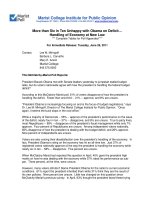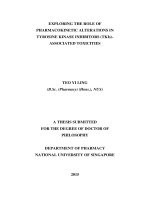Haemato-biochemical alterations in dogs affected with superficial pyoderma
Bạn đang xem bản rút gọn của tài liệu. Xem và tải ngay bản đầy đủ của tài liệu tại đây (132.12 KB, 5 trang )
Int.J.Curr.Microbiol.App.Sci (2019) 8(5): 1759-1763
International Journal of Current Microbiology and Applied Sciences
ISSN: 2319-7706 Volume 8 Number 05 (2019)
Journal homepage:
Original Research Article
/>
Haemato-Biochemical Alterations in Dogs Affected
with Superficial Pyoderma
R.K. Khinchi*, S.K. Sharma, Deepika Goklaney, Sandhya Morwal and Manju
Department of Veterinary Medicine, College of Veterinary and Animal Science,
Navania, Udaipur, India
*Corresponding author
ABSTRACT
Keywords
Dogs, Superficial
Pyoderma,
Haematobiochemical
Article Info
Accepted:
15 April 2019
Available Online:
10 May 2019
The present study was conducted on 205 dogs of different sex, age and breeds affected
with dermatological affections for a period of one year i.e. July 2017 to June 2018. Based
on diagnosis, 205 dogs were found affected with dermatological affections. Among 205
dogs, (15.61%) 32 dogs were found affected with superficial pyoderma. The values of
haemoglobin in dogs affected with superficial pyoderma were found significantly lower
and values of packed cell volume were found non-significantly lower as compared to
healthy control. The mean values of total leukocyte count were significantly higher and
mean value of total erythrocyte count was significantly lower in superficial pyoderma
affected dogs. The differential leukocyte count showed significant neutrophilia and
lymphopenia in superficial pyoderma affected dogs. Non-significant difference was
observed in the serum ALT, AST, BUN, creatinine, total protein and albumin values. The
mean value of glucose was significantly decreased in dogs affected with superficial
pyoderma.
Introduction
Superficial pyoderma is a bacterial infection
confined to the superficial portion of the skin.
Bacteria may cause an infection secondary to
local trauma, scratching, contamination due to
poor
grooming,
seborrhea,
parasitic
infestation, hormonal factors, local irritants
and allergies in dogs (Bajwa, 2016). Lesions
may be quite superficial and may affect only
the epidermis or may involve deeper
structures in the dermis or subcutaneous
tissue. Pyoderma is classified according to the
depth of infection as surface, superficial and
deep pyoderma. Canine superficial pyoderma
is defined as a superficial bacterial infection
of the epidermis and hair follicles and is
usually secondary to allergic, parasitic,
endocrine,
immune-mediated
and
conformational or keratinisation disorders
(Scott et al., 2001; Patel, 2006and Pinchbeck,
2010.).
Materials and Methods
In present study 205 dogs were reported at
Veterinary Clinical Complex of college of
Veterinary and Animal Science, Navania,
1759
Int.J.Curr.Microbiol.App.Sci (2019) 8(5): 1759-1763
Udaipur with different dermatological
affections. Superficial pyoderma in dogs was
diagnosed on the basis of history and clinical
examination. The dogs having superficial
pyoderma was subjected to detailed physical
examination viz. general condition, signs of
itching, general appearance, behavior, body
condition etc.
mean value of total erythrocyte count
(million/mm3) was significantly (p<0.05)
decreased in superficial pyoderma affected
dogs (6.29±0.067) as compared to healthy
control group (6.74+0.212). Non-significant
decrease was recorded in mean value of
packed cell volume of affected dogs as
compared to healthy group.
Hematological examination was conducted as
per standard technique to determine
haemoglobin (Hb), Packed Cell Volume
(PCV), Total Erythrocyte Count (TEC), Total
Leukocyte Count (TLC), Differential
Leukocytes Count (DLC) by (Feldman et al.,
2000). All the biochemical parameters viz.
ALT, AST, BUN, Creatinine, serum glucose,
total protein and Albumin were estimated by
using Automated serum biochemistry
Analyzer (IDEXX Vet test chemistry
analyzer)
The mean±SE values of neutrophils,
lymphocytes, monocytes and eosinophils
count in healthy control group and dogs
affected with superficial pyoderma were
69.67+0.989
and
78.22±0.655
%;
23.34+0.667 and 16.91±0.703 %; 2.84+0.402
and 1.91±0.158 %; 4.17+0.402 and
2.67±0.203 %, respectively. The differential
leukocyte count (%) in superficial pyoderma
dogs showed significant (p<0.01) neutrophilia
and lymphocytopenia as compared to healthy
control group. A non-significant (p>0.05)
difference of mean values of monocyte
(1.91±0.158 and 2.84+0.402) and eosinophils
(2.67±0.203 and 4.17+0.402) were recorded
in superficial pyoderma affected dogs as
compared to healthy control dogs.
Results and Discussion
Mean+SE
values
of
haematological
parameters in healthy and dogs affected with
superficial pyoderma are presented in Table 1.
The mean values of haemoglobin, packed cell
volume, total erythrocytes counts and total
leukocyte counts in healthy dogs and dogs
affected with superficial pyoderma were
14.09+0.414
and
12.60±0.183
g/dl;
38.99+0.804 and 37.32±0.418 %; 6.74+0.212
and
6.29±0.067
million/mm3;
and
11.58+0.242 and 15.05±0.194 per mm3,
respectively.
The mean±SE value of hemoglobin in dogs
affected with superficial pyoderma were
significantly (p<0.01) lower (12.60±0.183)
g/dl as compared to healthy control group
(14.09+0.414) g/dl. The mean value of total
leukocyte count (per mm3) were significantly
(p<0.01) higher (15.05±0.194) in superficial
pyoderma affected dogs as compared to
healthy control group (11.58+0.242). The
These findings of present investigation were
in accordance with that of Nair and Nauriyal
(2007); Gera et al., (2009) and Beigh et al.,
(2013). The decreased hematological indices
(Hb and TEC) recorded in the present
observations might be due to the prolonged
reduced appetite and/or blood loss from
scratching and inflammatory response of the
body due to these infections (Sharma et al.,
2013).
Stress and bacterial toxins had been suggested
as possible reason for marked leukocytosis
(Aujla et al., 1997). The increased TLC was
associated with neutrophilia and concomitant
lymphopenia.
Neutrophilia
with
corresponding lymphopenia were also
reported by Shyma and Vijaykumar (2011);
Beigh et al., (2013) and Thapa and Sarkar
1760
Int.J.Curr.Microbiol.App.Sci (2019) 8(5): 1759-1763
(2018). Statistically significant (P<0.01)
neutrophilia may be attributed to the cell
injury which in turn caused the release of
substances
such
as
leukotrien
and
leukocytosis promoting factors from the blood
into the injured areas resulting in release of
more neutrophils into the blood stream.
Serum biochemistry
Mean+SE values of serum biochemical
parameters in healthy control dogs and
superficial pyoderma affected dogs is
presented in Table 2. Serum biochemical
values in apparently healthy animal recorded
were within the normal range reported by
Villers (2005).
The mean±SE values of serum ALT, AST,
BUN, Creatinine and Glucose recorded in
apparently
healthy
dogs
were
35.84±4.848U/L,
17.84±2.664U/L,
11.84±2.198 mg/dl, 0.88±0.12 mg/dl and
99.5±3.931 mg/dl respectively.
Table.1 Mean+SE values of haematological parameters in healthy dogs and superficial
pyoderma affected dogs
Haematological
Parameters
Hb (g/dl)
PCV (%)
TEC (million/mm3)
TLC (per mm3)
Neutrophils (%)
Lymphocytes (%)
Monocytes (%)
Eosinophils (%)
Healthy Group
Superficial pyoderma affected
(n=6)
dogs(n=32)
14.09+0.414
12.60**±0.183
38.99+0.804
37.32±0.418
6.74+0.212
6.29*±0.067
11.58+0.242
15.05**±0.194
Differential Leucocytes counts
69.67+0.989
78.22**±0.655
23.34+0.667
16.91**±0.703
2.84+0.402
1.91±0.158
4.17+0.402
2.67±0.203
*: Means differ significantly (p<0.05) with control group
**: Means differ highly significant (p<0.01) with control group
Table.2 Mean+SE values of serum biochemical parameters in apparently healthy and superficial
pyoderma affected dogs
Biochemical
Parameters
ALT (U/L)
AST (U/L)
BUN (mg/dl)
Creatinine (mg/dl)
Glucose (mg/dl)
Total Protein (g/dl)
Albumin (g/dl)
Healthy Group
(n=6)
35.84+4.848
17.84+2.664
11.84+2.198
0.88+0.12
99.5+3.931
6.12+0.233
2.8+0.094
*: Means differ significantly (p<0.05) with control group
**: Means differ highly significant (p<0.01) with control group
1761
Superficial pyoderma affected
dogs(n=32)
39.34+1.353
20.50+0.594
12.72 + 0.582
0.89±0.043
89.71*±1.397
6.42±0.085
2.6±0.073
Int.J.Curr.Microbiol.App.Sci (2019) 8(5): 1759-1763
The mean±SE values of serum ALT, AST,
BUN, Creatinine and Glucose recorded in
superficial pyoderma affected dogs were
39.34+1.353 U/L, 20.50+0.594 U/L, 12.72
+0.582 mg/dl, 0.89±0.043 mg/dl and
89.71±1.397mg/dl
respectively.
No
significant changes (p<0.05) were observed in
the serum ALT, AST, BUN and Creatinine in
superficial pyoderma affected dogs when
compared to healthy control group. While
statistically significant decrease (p<0.05) in
the mean value of glucose was observed in
dogs affected with superficial pyoderma. The
findings of present investigation are in
agreement with that of Shyma and
Vijaykumar (2011) and Lodh and Das (2013).
The mean±SE values of serum total protein
and albumin recorded in apparently healthy
dogs were 6.12±0.233 g/dl and 2.8±0.094
g/dl, respectively. The mean±SE values of
serum total protein and albumin in superficial
pyoderma affected dogs were 6.42±0.085 g/dl
and 2.6±0.073 g/dl, respectively. Nonsignificant increase (p>0.05) was observed in
the mean values of total protein and nonsignificant decrease was observed in albumin
values in dogs affected with superficial
pyoderma than apparently healthy dogs.
These findings are in close agreement with
that of Sharma et al., (2013). Non-significant
differences in total serum protein and albumin
values were observed in present study might
be due to increased inflammatory response
assorted with infection (Shyma and
Vijayakumar, 2011).
References
Aujla, R.S., Singh, N., Sood, N., Gupta, P.P.
and Sodhi, S. (1997). Bacterial
dermatitis in dogs in Punjab
prevalence and clinicopathological
studies. Indian Veterinary Journal, 74:
837-840.
Bajwa, J., (2016). Canine superficial
pyoderma
and
therapeutic
considerations. Can. Vet. J., 57(2):
204-206.
Beigh, S. A., Sudan J. S., Singh, R. and Khan,
A. M. (2013). Trace mineral status and
antioxidative enzyme activity in dogs
with
generalized
demodecosis,
Veterinary Parasitology, 198 (1-2):
180-186.
Feldman, B.F., Zinki J G and Jain N C
(2000).
Schalms
veterinary
haematology, 5 edn. Lippincott
Williams and Wilkins, Phildelphia,
1344-1348.
Gera, S., Khurana, R., Jakhar, K. K., Garg, S.
L. and Arya, S. (2009). BloodBiochemical studies in skin affections
in dogs. Indian Journal of Veterinary
Research 18(1): 23-26.
Lodh, C., and Das, S. (2013). Prevalence of
canine bacterial dermatitis in west
Bengal. Indian Journal of Canine
Practice, 5(I): 109-113.
Nair, SS., and Nauriyal. (2007). Diagnostic
significance
of
haematological
changes associated with various
canine dermatoses. Intaspolivet 8(I):
68-72.
Patel, A. (2006). Bacterial pyoderma
consultation
in
feline
internal
medicine. Elsevier Saunders, St. Louis
5: 251.
Pinchbeck, L. R., (2010). New approaches to
the
management
of
canine
pyoderma.82th Western Veterinary
Conference 73: 14-18.
Scott, D. W., Miller, W. H. and Griffin, C. E.
(2001). Muller and Kirk’s Small
Animal Dermatology 6th edition
Philadelphia, WB Saunders Company,
pp. 230- 232,274- 335, 647- 650.
Shyma, V.H., and Vijaykumar, K. (2011).
Haematobiochemical studies in dogs
affected with bacterial dermatitis.
Journal
of
Veterinary
Animal
Sciences, 42: 20-22.
1762
Int.J.Curr.Microbiol.App.Sci (2019) 8(5): 1759-1763
Sharma, S K., Soodan J S, Hussain K and
Tikoo,
A.
(2013).
Clinical
management of canine bacterial
dermatitis. Intaspolivet, 14(II): 381384.
Thapa, G., and Sarkar, S. (2018).Occurrence
of Canine Skin Disorder and its
Haematobiochemical
Alterations.
Int.J.Curr.Microbiol.App.Sci, 7(12):
184-195,
Villers,
E.
(2005).
Introduction
to
haematology. In BASAWA manual of
canine and feline pathology, 2ndEdn,
Villers E and Blackwood L, BASAWA,
Gloucester, UK. Pp. 33-60.
How to cite this article:
Khinchi, R.K., S.K. Sharma, Deepika Goklaney, Sandhya Morwal and Manju. 2019. HaematoBiochemical
Alterations
in
Dogs
Affected
with
Superficial
Pyoderma.
Int.J.Curr.Microbiol.App.Sci. 8(05): 1759-1763. doi: />
1763









